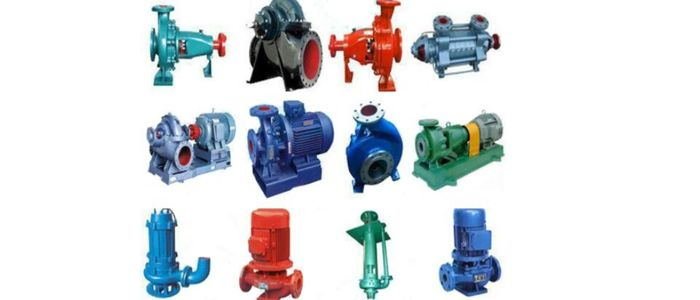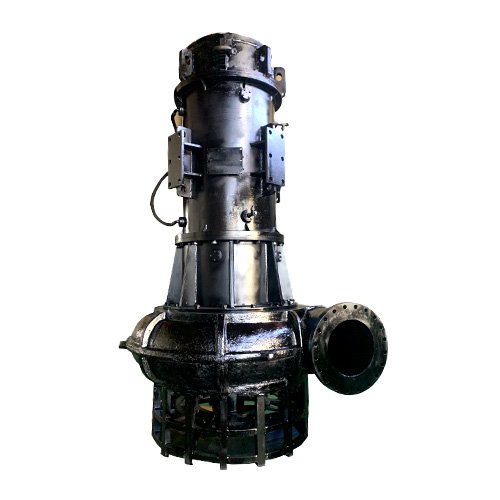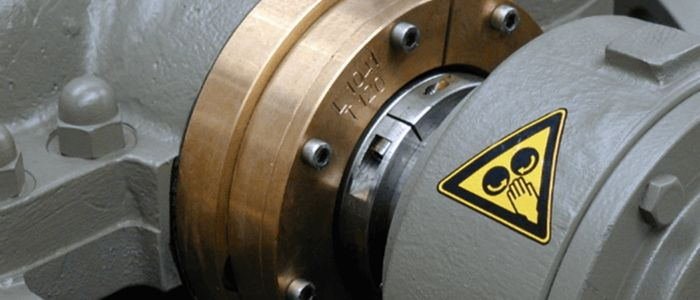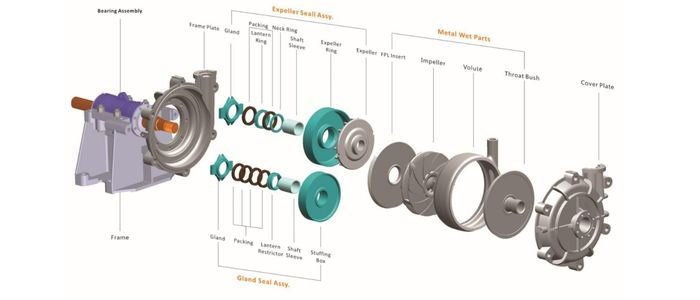Slurry pumps are a form of centrifugal pumps. In its basic concept, a slurry pump is a type of machine that increases the energy of a solid-liquid mix medium through the force of centrifugal (the rotating impeller in the pump) and converts electric energy into the potential energy and power of the material.
There are varieties as well as models for slurry pumps. Slurry pumps of various types are used extensively for the transportation of slurry in metallurgical concentrators. Ash removal within thermal power stations coal slurry, heavy medium transport in coal washing facilities as well as slurry lifting for wash plants for sand and river dredging.

Here are the four most important types of slurry pumps:
- Horizontal Slurry Pump
- Vertical Slurry Pump
- Submerged Slurry Pump
- Submersible Slurry Pumps
Horizontal Slurry Pump
If the location of the shaft of the pump is in a parallel position to the plane of horizontality, it’s known as the Horizontal Slurry Pump. The horizontal slurry pump is an axial single-suction single-stage horizontal centrifugal pump that cantilevers strong and wear-resistant components for the overflow components. Depending on the Suction Media, filter parts comprised of different materials can be swapped.
Horizontal slurry pumps can be used to convey abrasion-resistant or high-concentration and corrosive fine or large particle slurry. This series of slurry pumps are extensively utilized in metallurgy mining, coal mines, electric power, and many other industries to move an abrasive slurry that contains a massive amount of solid material.

Vertical Slurry Pump
If the position of the shaft of the pump is parallel to the horizontal, it’s called Vertical Slurry Pump. The vertical slurry pump is utilized within the pool for pumping the slurry. Additionally, the pump head is placed at a distance from the liquid level, which is why it is also known as the “Submerged” Slurry Pump however, not all pumps are submerged in the water. If the motor, as well as other non-pump head parts, are also included in the slurry, it is known as Submersible Slurry Pump.
Vertical slurry pumps are used for the conveyance of corrosive fine particles and high concentrations of slurry
Submerged Slurry Pump
A submerged Slurry Pump is an upright, single-stage, single-suction beam centrifugal pump. The impeller is semi-open, and a mixing blade is placed on the suction edge of the impeller.
The greatest remarkable features of the submerged Slurry pump are its length shaft in the submerged area is in the range of 800-2000mm. There are no bearings among the impeller as well; in the case of the pump, the dynamic unit is positioned on the motor precaution and seat using the upright engine. The connector is utilized to link to the pump.
Submerged Slurry Pump is mostly utilized in municipal engineering paper mills, cement factories, printing, dyeing factories, and various other sectors to move slurry quicksand, sludge, and other fluids.
Submersible Slurry Pump
The submersible Slurry Pump is the coaxial connection of the pump and motor, and the engine is submerged in the slurry. It is not necessary to create elaborate fixtures or safeguards on the ground. The motor is secured by an electronic seal, which effectively stops high-pressure water as well as impure substances from entering the cavity. The stirring impeller is in contact with the deposition surface directly, and the concentration of slurry is determined by the depth of the dive. The slurry is then pumped into the pump, thereby saving energy.
Submersible slurry pumps are suitable to transport slurry that contains Abrasive particles, such as tailings, sand and cinder, and more. It is used primarily in electric power, metallurgy as well as the dredging of rivers as well as sand extraction and municipal mud processes, and other industries.

Basic Structure of Slurry Pump
Pump Head
The pump body is a Double-layer housing for the pump (double-layer metal structure on both sides) the double-pump housing is vertically split, with the discharge water able to be placed and utilized in a variety of places according to the 45-degree intervals.
To effectively stop the loss of seals in the shaft to prevent shaft seal leakage, the combination of packing seal, power seal, or mechanical seal has been used.
Labyrinth clearance seals are placed between the impeller and the back guard plate. This greatly decreases the flow of slurry through the stuffing box and also guarantees the integrity of the seal.
Bracket Structure
The structure of the brackets in a Slurry Pump has the horizontal split type as well as the barrel type. Proper selection of the form of the bearing as well as model, cooling, mode of lubrication as well as other parameters. To ensure that the radial force, as well as the axial force, can be evenly dispersed to prolong the lifespan that the bearing.
Shaft Seal
The shaft seal is an important role in sealing the pump body and shaft of the pump. This can stop air from getting into the pump, as well as a substantial amount of water from spilling out from the pump. The forms of shaft seal include an Auxiliary impeller power seal, sealing seal for packing, and mechanical seal

Bearing Assembly
The Slurry pump’s bearing assembly utilizes a cylinder design which makes it convenient to alter the distance between the impeller and the front guard board and can be taken apart when it is time for maintenance. The bearing is greased with grease.
Driving Device
Elastic coupling drive as well as a narrow drive with a V-belt with variable frequency drive.
How does a Slurry pump Function?
The basic principle behind the Slurry Pump is that it operates under the influence of the centrifugal force, the slurry or mud is thrown out from the center of the impeller until the outer edge, and it then gets energy that allows it to exit the outer edges of the impeller, and then into the volute pump shell at high speed. In the shell of the volute pump, the slurry slows because of the expansion of the channel, and it converts some of the kinetic energy to static pressure energy. Then, eventually, enters the discharge pipe with higher pressure and sends it to where it is required.
If the slurry flows from the center of the impeller to the outside edge that is the outer edge of that impeller a vacuum develops within the middle of the impeller. Since the pressure over the liquid level in the storage tank is higher than the pressure at the inlet to the pump, the fluid will be constantly pressed into the impeller, creating a slurry pump that feeds continuously.

How to Select the Finest Slurry Pump
The proper selection of the slurry pump is one of the main aspects of extending the lifespan of the pump and reducing costs for slurry pumps. The proper selection of a slurry pump includes an appropriate choice of the type of pump, its performance parameters, and the material of overcurrent components, seal type, transmission mode, and more.
The following seven steps help you how to choose the right type of slurry pump to meet your requirements:
1. The first step is to determine the kind of slurry pump
That is decided on the customer’s local working conditions. Horizontal slurry pumps are suitable to import at some pressure, while vertical slurry pumps are suitable for mud pools.
2. By the acidity and alkalinity levels of the slurry, it is possible to determine the material employed to construct the overflowing parts.
For example, acidity could be made of A49, Cr30, or natural rubber. For large particles and impact-resistant pulp, it is preferential to select metal material flow passages that are wear-resistant, and for smaller particles, and edges that are not sharp corners pulp, it’s preferable to use materials flow passages made of rubber.
3. The variety of the motor-powered slurry pump.
Motor power for the slurry pump must be 1.2 times its shaft’s power because power loss could be due to interaction between the slurry and pump body as well as the overloading process in the operation of the pump.
4. Choose the sealing method.
There are three types of sealing techniques, including a packing seal pressure relief cover, an auxiliary impeller seal, and a mechanical seal.
5. Check the type of drive.
The most common driving options for Slurry pumps are triangles with a V shape belt drive, elastic coupling drive, gear reducer drive, hydraulic coupler drive, Frequency conversion drives, and SCR speed regulation. The prices of flexible couplings as well as V-shaped triangular belts are less and are easier to disassemble and assemble; therefore, they should be considered first.
6. By the head and flow parameters specified by the client
The right Slurry pump is chosen depending on the performance curve of water for the slurry pump following the surplus is increased, and the motor’s power is calculated.
7. Collaboration with clients
Check the footprints of the work site with the user and create the drawings for the installation and explain the necessary installation instructions for the Slurry Pump.


